Today’s trip–joining a group of mostly AUI faculty and students who have come to distribute blankets to migrant communities around the Moroccan city of Oujda–has been preceded by a fair bit of soul-searching. A member of the migrant community here, a man known as El Adj (say the newspapers, or perhaps El Hajj, the boss) was brutally murdered a few weeks ago, and there were worries that a foreign presence might intensify problematic police attention on the migrant communities. A few days after the original news of his death, we heard more details: that he was a Ghanaian who had been kidnapped by Nigerians at the university; that he had escaped and reported his abduction to the police; that the police were planning to arrest the Nigerians but the Nigerians had gotten to him first; that they had killed and dismembered him as a warning to others who attempted to escape.
Karen Smith, the university chaplain leading this trip, is confident there is no danger to westerners, but she still worried some about bringing the students. Two days before we left Ifrane, I was trying to explain to Jeremy what we would be doing in Oujda, but he had heard the word police associated with the trip in some other context and his anxiety-antennae were fully activated. “No, no,” I told him: if there were any danger, we would whisk you away.” But the conversation gave me pause. I had a sudden flashback to the anxiety caused before our departure for Morocco by the news that a French family had been kidnapped in Algeria. “Really?” I said to James that evening. “Last year, we worried about coming to Morocco because it’s next to Algeria, but now we’re going to take the children right to the site of an international kidnapping and murder?” Evidently so. “What kind of a message does it send if the Westerners are too frightened to come?” both James and Karen asked, rhetorically. “Neither the migrants nor the students have the option of staying away, and they are the ones truly at risk.” So here we are, eating our breakfast and listening to Karen give us the background to their story.
This newspaper article from August 9, 2013, may mark the nadir of migrant conditions in Morocco.
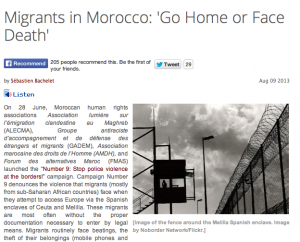
“We knew there was a problem back in the year 2000,” Karen tells us . “Literally, from one week to the next, the English-speaking congregation in Rabat and Casa jumped from 100 people to 200 people. Before that year, the major trafficking routes ran through Libya, but then either Libya found new ways to block the traffic or the country became more lawless, and the routes shifted to Morocco.

A Moroccan friend back in Ifrane will later suggest that Algeria intentionally decided to cause trouble for Morocco by sending the migrants west instead of east. Clearly, as these journal covers of the weekly Maroc Hebdo suggest, the issue of migrants raises many issues in Morocco. Racism, anyone?
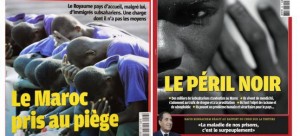
But note too that Morocco is being pressed by the EU to patrol European borders–to be the bad cop for European interests.
Karen tells us the story behind the map of migration routes (above): “You can start out alone, on foot, but eventually you have to pay someone to tell you where to go: you join up with the traffickers. No one leaves their country lightly. The people I’ve interviewed from Cameroon, for instance, many of them are orphans. In urban centers, the social network has collapsed, and there’s no one to care for these orphans. So you do what you can do: you start walking. Or else people come from the rural communities, and these communities are dying, and they choose one person, a courageous person, to go and find work and send money home. I wouldn’t have the courage, to take that walk.
“People come from many places, especially where there is violence and upheaval—from the Congo, from Nigeria, from Cameroon, it could be anywhere. From Nigeria, the road lies through Niger and across the Sahara into Algeria.
(At the end of October, 92 migrants–52 children, 33 women, 7 men–died of thirst in Niger when the trucks transporting them broke down. Their deaths sparked a major investigation into the trafficking of migrants through Niger.)
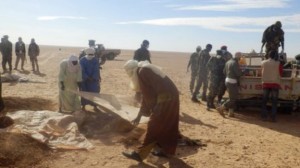
Associated Press image of mass grave in Niger, published in itv, October 31, 2013
“In Algeria, the migrants find their way to Maghnia, where they are organized by the traffickers into groups. Those groups are sent across the border into Morocco, knowing at least where they are going and who will be looking out for them in the short term. They come to camps that are often organized according to place of origin. So in the forest, there will be one camp that is “Empire State” and another that is “Ito State”—these are two states in Nigeria, and everyone or almost everyone in the camp will be from that state, whether they started out together or not.
“After that, people try to get to Spain, in order to move deeper into the Eurozone to find work. They have one chance to cross, and if something doesn’t work—if the boat doesn’t leave, or if the police disrupt an attempted crossing—that’s it: they’ve lost their money, and they have to wait until they can save up enough money to pay to cross again.
“Many migrants suffer violence from police or army forces, Moroccan or Spanish, in their efforts to cross the border.
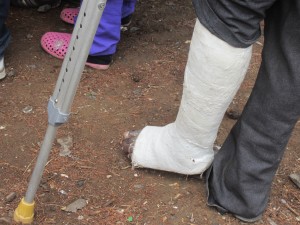
A documentary by Sara Creta (Number 9: Stop violence at the borders!) released in late spring 2013 recorded the testimonies of migrants in the Gourgourou forest (near the Spanish enclave of Nador) who had suffered violence in their attempt to cross the borders.
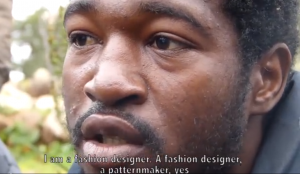 Screen grab from “Number 9”
Screen grab from “Number 9”
The film is named for a migrant who died during the filming–a man known as Clément, who liked to wear a Number 9 football shirt.
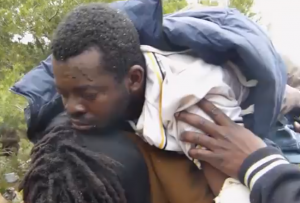 Screen grab from “Number 9”
Screen grab from “Number 9”
“Still, despite efforts like the Number 9 campaign, the treatment of migrants continued to worsen. Up to the end of this past summer, policies were more and more draconian. Migrants have been beaten and left in a pit for dead; when I was here earlier this year we spoke with some Cameroonians who had just come back from an attempted crossing and told us about security forces trying to drown them, and they were shaking from the experience. One, I think his name was Abdelrachman, was a little crazed: he could barely speak about it. The idea behind this kind of abuse seems to be to discourage migrants from coming to Morocco, but people don’t realize what they’re getting into when they start down the migration trail—and once they arrive here, they don’t have the resources to make other choices.
“The women are the most vulnerable: they have been forced into prostitution, many of them, or assigned a protector, and basically all of them have been raped. They’re really not all right.
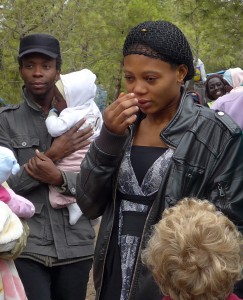
“But this fall, CEI helped put together a report on the migrant situation, and this was presented to the king, and he said publicly that something must be done. Almost immediately, it was announced that Morocco would give work permits to people whose refugee status had been recognized by the UN High Commission on Refugees—though that’s only about 8500 people out of the thousands of migrants in the country.”
Morocco has also been angling for a position on the UN High Commission on Refugees and it finally got that position. On the day that appointment was announced, Morocco also proclaimed a jubilee year granting amnesty to some of the 25-45,000 illegal migrants in the country. Trafficking expert Terry Coonan, visiting Ifrane a week after our trip to Oujda, called the pair of announcements a process of “improving human rights practices by increasing Morocco’s visibility.”
“So,” Karen concludes, gathering us together to leave for the camps, “there is new hope for the migrants—not that they will achieve their dreams of making a new life in Europe, but that their experience in Morocco might be something less of a nightmare.”